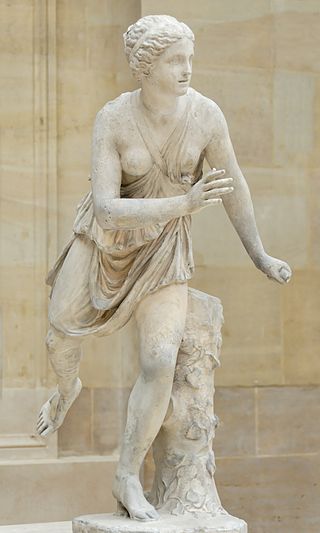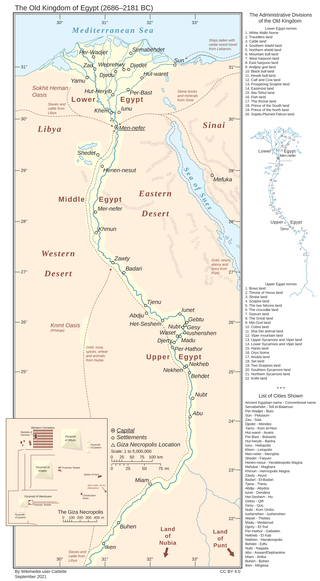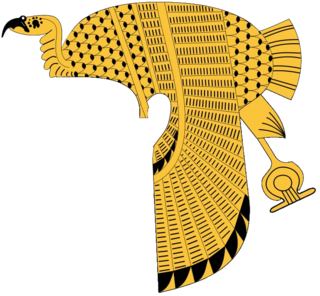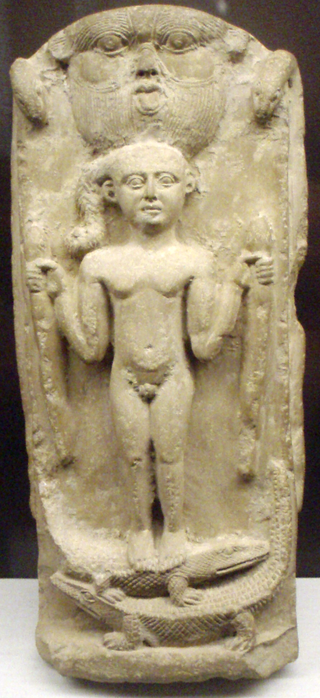Related Research Articles

Atalanta is a heroine in Greek mythology.

Nekhbet is an early predynastic local goddess in Egyptian mythology, who was the patron of the city of Nekheb. Ultimately, she became the patron of Upper Egypt and one of the two patron deities for all of Ancient Egypt when it was unified.

In ancient Egyptian history, the Old Kingdom is the period spanning c. 2700–2200 BC. It is also known as the "Age of the Pyramids" or the "Age of the Pyramid Builders", as it encompasses the reigns of the great pyramid-builders of the Fourth Dynasty, such as King Sneferu, who perfected the art of pyramid-building, and the kings Khufu, Khafre and Menkaure, who constructed the pyramids at Giza. Egypt attained its first sustained peak of civilization during the Old Kingdom, the first of three so-called "Kingdom" periods, which mark the high points of civilization in the lower Nile Valley.

The Middle Kingdom of Egypt is the period in the history of ancient Egypt following a period of political division known as the First Intermediate Period. The Middle Kingdom lasted from approximately 2040 to 1782 BC, stretching from the reunification of Egypt under the reign of Mentuhotep II in the Eleventh Dynasty to the end of the Twelfth Dynasty. The kings of the Eleventh Dynasty ruled from Thebes and the kings of the Twelfth Dynasty ruled from el-Lisht.

Lois Mailou Jones (1905–1998) was an artist and educator. Her work can be found in the collections of the Smithsonian American Art Museum, The Metropolitan Museum of Art, the National Museum of Women in the Arts, the Brooklyn Museum, the Museum of Fine Arts, Boston, Muscarelle Museum of Art, and The Phillips Collection. She is often associated with the Harlem Renaissance.

Ancient Egyptian art refers to art produced in ancient Egypt between the 6th millennium BC and the 4th century AD, spanning from Prehistoric Egypt until the Christianization of Roman Egypt. It includes paintings, sculptures, drawings on papyrus, faience, jewelry, ivories, architecture, and other art media. It was a conservative tradition whose style changed very little over time. Much of the surviving examples comes from tombs and monuments, giving insight into the ancient Egyptian afterlife beliefs.

Panehesy was an Egyptian noble who bore the titles of 'Chief servitor of the Aten in the temple of Aten in Akhetaten'.

Joyce Ann Tyldesley is a British archaeologist and Egyptologist, academic, writer and broadcaster who specialises in the women of ancient Egypt. She was interviewed on the TV series 'Cunk on Earth', about Egypt's pyramids, in 2022.

The Michael C. Carlos Museum is an art museum located in Atlanta on the historic quadrangle of Emory University's main campus. The Carlos Museum has the largest ancient art collections in the Southeast, including objects from ancient Egypt, Greece, Rome, the Near East, Africa and the ancient Americas. The collections are housed in a Michael Graves designed building which is open to the public.

The Ptolemaic Kingdom or Ptolemaic Empire was an Ancient Greek polity based in Egypt during the Hellenistic period. It was founded in 305 BC by the Macedonian general Ptolemy I Soter, a companion of Alexander the Great, and ruled by the Ptolemaic dynasty until the death of Cleopatra VII in 30 BC. Reigning for nearly three centuries, the Ptolemies were the longest and final dynasty of ancient Egypt, heralding a distinctly new era for religious and cultural syncretism between Greek and Egyptian culture.

In Ancient Egyptian society, hair was an embodiment of identity. It could carry religious and erotic significance and portray information about gender, age, and social status. During the New Kingdom, more elaborate hairstyles for men and women, incorporating curls and plaits, began to be favored over the traditional, simple hairstyles of the Old and Middle Kingdoms.

Iuput II was a ruler of Leontopolis, in the Nile Delta region of Lower Egypt, who reigned during the 8th century BC, in the late Third Intermediate Period.

Heroic nudity or ideal nudity is a concept in classical scholarship to describe the un-realist use of nudity in classical sculpture to show figures who may be heroes, deities, or semi-divine beings. This convention began in Archaic and Classical Greece and continued in Hellenistic and Roman sculpture. The existence or place of the convention is the subject of scholarly argument.

An artistic canon of body proportions, in the sphere of visual arts, is a formally codified set of criteria deemed mandatory for a particular artistic style of figurative art. The word canon was first used for this type of rule in Classical Greece, where it set a reference standard for body proportions, to produce a harmoniously formed figure appropriate to depict gods or kings. Other art styles have similar rules that apply particularly to the representation of royal or divine personalities.

Mentuemhat or Montuemhat was a rich and powerful Theban official from ancient Egypt who lived during the Twenty-fifth Dynasty of Egypt and Twenty-sixth Dynasty of Egypt. He was the Fourth Priest of Amun in Thebes.

The Vulture crown was an ancient Egyptian crown worn by Great Royal Wives and female pharaohs. It was depicted as a headdress in the shape of a vulture draped over the head, with its wings hanging down on the sides. It was a symbol of protection associated with the vulture goddess Nekhbet, who often wore this crown when depicted in a human form. These crowns were frequently worn by the Great Royal Wife, high ranking priestesses, and female pharaohs. These crowns were also sometimes equipped with the Uraeus to symbolize Wadjet, representing both Upper (Nekhbet) and Lower Egypt (Wadjet).
Arietta Papaconstantinou is Reader in Classics at the University of Reading and Associate Faculty Member in the Faculty of Oriental Studies, University of Oxford. She is an expert in the religious, social and economic history of Egypt and the Near East during the transition from the Roman Empire to the Caliphate.

Edith Nason Buckingham was an American zoologist, dog breeder, and chicken farmer. She was the first woman to earn a Ph.D. in zoology at Radcliffe College.

Horus on the Crocodiles is a motif found on ancient Egyptian healing amulets from the Third Intermediate Period until the end of the Ptolemaic dynasty, as well as on larger cippi and stelae. Both the portable amulets and the larger statues are sometimes referred to simply as Horus stelae.
References
- 1 2 3 "Gay Robins". arthistory.emory.edu. Emory University. Archived from the original on 8 March 2017. Retrieved 8 March 2017.
- ↑ Jarus, Owen (April 5, 2013). "Hatshepsut: First Female Pharaoh". Live Science. Retrieved 2017-03-08.
- ↑ "Egyptian Painting and Relief". Bloomsbury Publishing. Retrieved 2017-03-08.[ permanent dead link ]
- ↑ "Women in Ancient Egypt — Gay Robins | Harvard University Press". www.hup.harvard.edu. Retrieved 2017-03-08.
- ↑ Meskell, Lynn (1997-11-01). "Engendering Egypt". Gender & History. 9 (3): 597–602. doi:10.1111/1468-0424.00078. ISSN 1468-0424. S2CID 247702496.
- ↑ Proportion and Style in Ancient Egyptian Art. University of Texas Press. 1993-06-05. ISBN 978-0-292-77064-5 . Retrieved February 5, 2019.
{{cite book}}:|website=ignored (help) - ↑ Peck, William H. (1999-07-01). "Proportion and Style in Ancient Egyptian Art. Gay Robins". Journal of Near Eastern Studies. 58 (3): 203–207. doi:10.1086/468713. ISSN 0022-2968.
- ↑ "The Art of Ancient Egypt — Gay Robins". www.hup.harvard.edu. Retrieved 2017-03-08.
- ↑ Riggs, Christina (Summer 2002). "Review of Gay Robins, The Art of Ancient Egypt (Harvard UP, 2000)". African Arts. 35 (2): 11, 88–89. doi:10.1162/afar.2002.35.2.11.